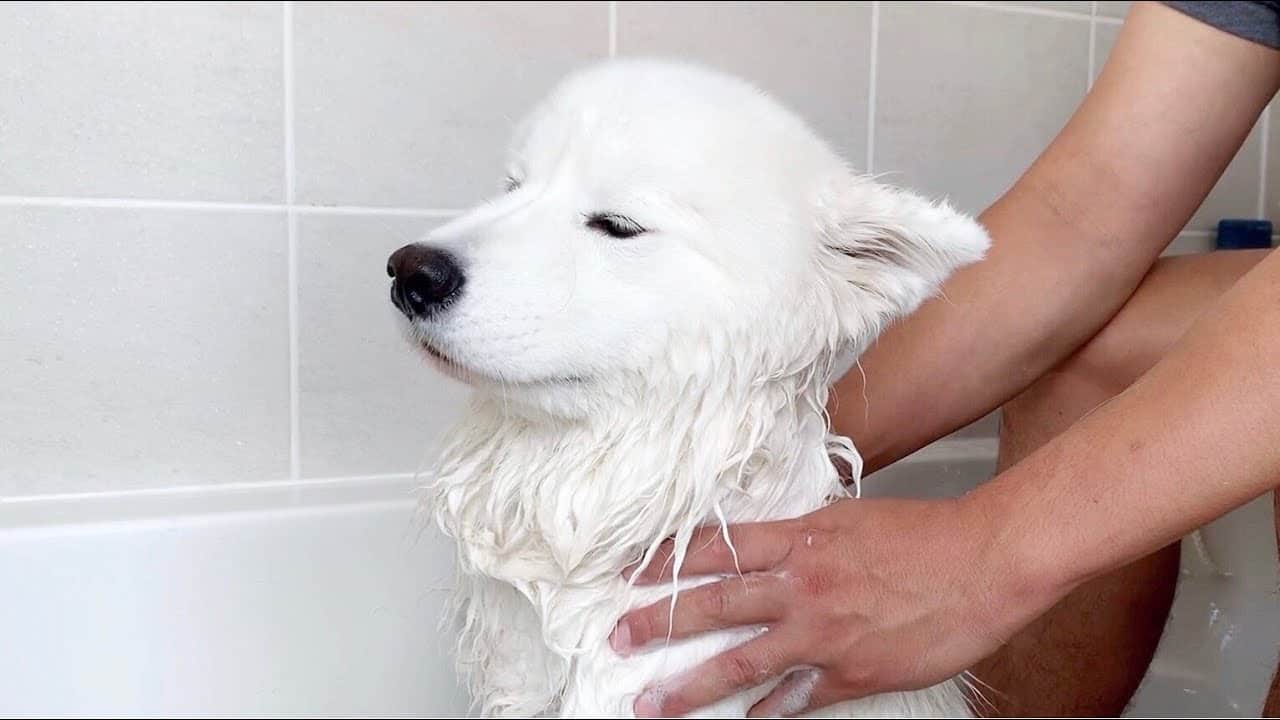Bathing a Samoyed at home can be carried out in a number of ways. Your own bathtub can act as a fine Sammy tub, with a rubber mat on the tub floor to prevent your Samoyed’s paws from slipping on slick porcelain or fiberglass, but in summer you may prefer to bathe the dog outdoors to prevent the need for a massive cleanup following the big event.
Another clever option for outdoor bathing is to transform a large plastic (clean) trashcan or children’s pool into a bathtub. Fill the receptacle with lukewarm water, lift your pet into it, and you will be amazed at how quickly and easily this enables you to thoroughly saturate the dog’s coat. Then take the now wet dog out of its makeshift tub, lather up the coat and use a garden hose with a light spray for the rinse.
Samoyeds are not what one would call water-loving dogs in the tradition of the Golden or Labrador Retrievers, yet most will tolerate the water when it’s time for a bath. Now, the owner of a dog with such a dense white double coat is not likely to relish the thought of attempting to saturate that coat down to the skin and then ensuring that every sud is rinsed from its strands, but that is the challenge that lies ahead as you prepare the bath.
Here, too, don’t discount the availability of the professional groomer, who is trained in such matters and has the equipment available to make the job easier.
Fortunately, bathing that coat is necessary only occasionally, usually every two or three months. Mother Nature apparently knew that a dog of such white and ivory splendor must be blessed with a coat that is somewhat self-cleaning, and indeed that is what you will find with the Samoyed. Also, the coat lacks the traditional “doggy” odor that most dogs share.
Preparations Before Bathing
However you choose to bathe the dog, proper preparation will make the job proceed much more smoothly. Gather all the supplies you will need—shampoo, towels, washcloths—and keep them within easy reach of the bathing site. Run the bath, and then go fetch the dog, who may at that moment, having witnessed the preparations, be hiding under the bed.
Before you begin the bath, a good brushing is in order to unravel any budding mats. Cut out any existing mats that you find, as these will only tighten with the bath.
Technique for Bathing
Once you have the dog in the tub, tackle the job of getting that coat saturated to the skin. In time you will learn how to do this most efficiently for your dog’s own particular tastes. For instance, some dogs don’t mind being bathed from neck to tail to toe, yet balk at having a wet head and ears.
For such a dog, wash the rest of the body first, and save cleaning of the face and ears for last (you may want to place cotton balls in the ears to prevent water from seeping in). Now apply the shampoo, which should also be worked in down to the skin.
The next step is the most difficult, and the most time-consuming: the rinse. You must ensure that every last bubble is removed from the dog’s coat and skin, as soap residue can dry and irritate the skin. Even when you believe you have accomplished your task and not a sud of soap remains, rinse again just to be sure. When you no longer see soap or bubbles falling from the dog, rinse one more time.
If you have reserved the washing of the dog’s face and head for the end, wash the head with a drop of shampoo and the face with a clean washcloth and water. Now fully bathed, the dog’s natural inclination will be to shake, and the amount of water that can cling to a coat of this type is phenomenal.
You will see this with the first shake as you and everything in the vicinity is suddenly as saturated as the dog. One way to reduce the flood, is to snap on the dog’s leash and take it outdoors to do its shaking (a natural task if you are already outdoors, of course).
The key word here, however, is “leash.” The dog that is allowed to run loose and shake is also the dog that is likely to begin rolling in the grass or even a mud puddle to remove the strange scents from its coat, and then you must start all over again.
Drying Your Samoyed
Your next task is to towel dry the dog gently from head to foot. If you dry the face and head first, the dog may be less inclined to roll, more inclined to cooperate with your drying and brushing efforts.
Complete drying can take an entire day, so make sure the dog remains somewhere in the home or outdoors where it is safe from catching a chill: perhaps help accelerate the process by taking a warm (not hot) blow dryer to the coat (most successful if you have previously introduced the blow dryer to the dog and convinced it that this strange and rather noisy machine poses no threat).
Brush the dog periodically throughout the day to remove the hairs that are inevitably released by the bathing process, and soon your dog will be just as clean, dry, and sweet-smelling as it is beautiful. You’ll both be quite pleased.

